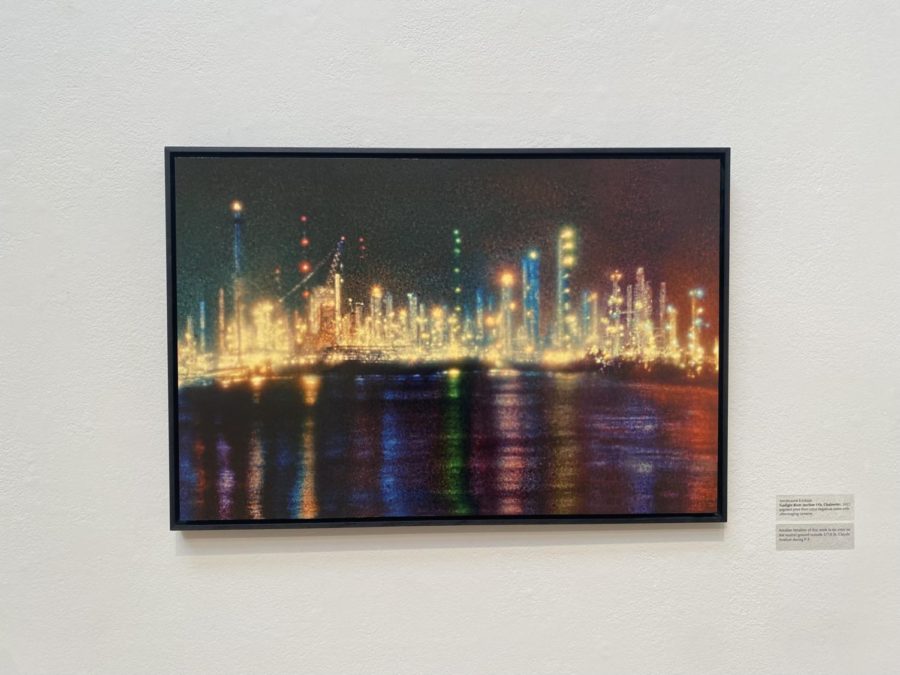Where We Are: Tulane Contemporary.5 evokes shared experience
“Gaslight River” by AnnieLaurie Erickson
March 8, 2022
On Wednesday, Feb. 23, The Woldenberg Art Center concluded its latest exhibition: “Where We Are: Tulane Contemporary.5,” an exhibit with a thematic approach to nostalgia and the subconscious. Created by studio art faculty and master of fine arts graduates, Contemporary.5 offered the viewer an elevated artistic experience. Despite the diversity of artistic approaches, the curation produced a cohesive narrative throughout the exhibit. Much of the work speaks to collective human experience, especially in Louisiana. Moving through this exhibit, one cannot help entering an introspective journey. Notions of familiarity and nostalgia are highlighted and questioned, imbuing the viewer with a unique curiosity.
Artist Diana Antohe’s vibrant embroidery demands careful attention. Through her practice, Antohe navigates a path of self-discovery. Her piece, “tin mult la tine, te tin la mine (in this holding pattern),” is a dynamic piece expressing the duality of Antohe’s identity. At a glance, the embroidery states “tin mult la tine, te tin la mine” –– I care about you, I care about you. Blending in with her abstract design, the embroidery whispers “in this holding pattern.” The exhibit catalog explains how her work emphasizes the “systems of value and care she has inherited from the examples of her parents and grandparents.” This tightly woven piece suggests the strong impact Antohe’s original citizenship has on her lifelong experiences. As a viewer, the textual quality of this piece relays a sense of familiarity and relatability.
One’s brain must work to make sense of Anthony Baab’s piece “Stores.” Despite its geometric quality, the abstractions within the aisles represent the surfacing of the subconscious within external — and seemingly benign — environments. Baab’s careful attention to detail is breathtaking and overwhelming; its surrealism does not allow the eye to rest. Baab’s ink drawing is designed to express a “horrifically vibrant world,” according to the piece’s exhibit catalog. Viewing Baab’s haunting yet captivating work was an immersive, hypnotic experience. I interpreted his piece as a commentary on societal organization and compartmentalization, which will inevitably unearth chaos.
My favorite piece was AnnieLaurie Erickson’s “Gaslight River,” a pigment print from color negatives taken with an after imaging camera. I immediately gravitated towards this piece. Erickson’s work invoked a personal nostalgia, reminding me of the Manhattan skyline. “Gaslight River” does not capture a city, however –– this piece reveals an enormous oil refinery, just one of the 150 studded along Louisiana’s Cancer Alley. Illuminated in the night, Erickson describes the sight as “strange forbidden cities starting fires in the sky.” By visually identifying the face of the fossil fuel industry, Erickson reveals its daunting, physical presence.
Contemporary.5 offers commentary on human transience and its inevitable environmental impacts. At Tulane University, it is easy to become wrapped up in the college experience and disassociate from the New Orleans community. With all of its complexity, New Orleans is an environmental anomaly. The introspective qualities of Contemporary.5 question what role we play — or want to play — in this community. Within their artistic expression, Contemporary.5 offers a potential answer, waiting to be uncovered.























Leave a Comment